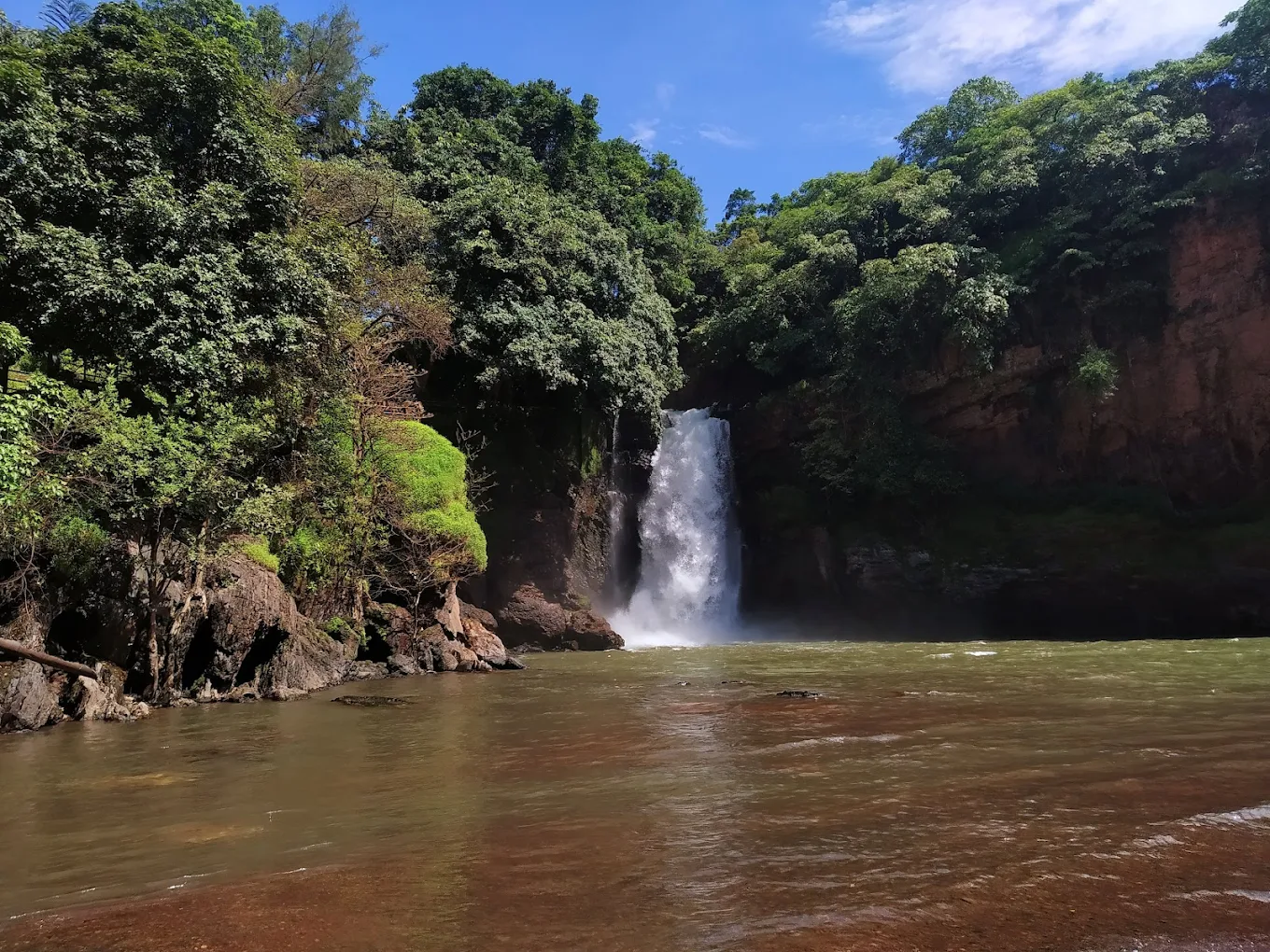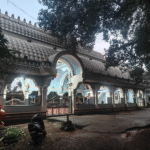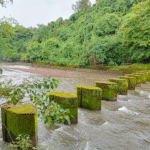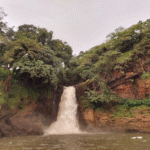
Arvalem Waterfall (also known as Harvalem Falls) is a serene yet breathtaking natural wonder tucked away in North Goa, just about 30 km east of Panaji near Sanquelim village . Cascading from a rocky cliff roughly 50 m (165 ft) high and roughly 7 m wide, its constant flow forms a deep, inviting pool at the bottom—like a hidden gem amidst the Western Ghats .
What Makes It Special
1. Striking Waterfall & Natural Pool:
Arvalem Waterfall drops impressively from a height of about 50 meters and spans 7 meters in width, forming a refreshing, natural pool at its base—ideal for a relaxing dip when water levels are safe.
2. Seasonal Beauty:
- During Monsoon (June–September):
The waterfall surges with powerful, muddy torrents, offering a dramatic and awe-inspiring sight.
- Post-Monsoon to Winter (October–March):
The flow becomes gentler, the water clears up, and the serene ambiance is perfect for swimming and capturing scenic photographs.
3. Easy Reach & Comfortable Setup:
Just a short stroll from the parking area, the site features user-friendly paths, a charming stone bridge, and a landscaped park, ensuring an effortless and enjoyable visit—no trekking required.
4. No Entry Fee & Daily Access:
The waterfall is open to visitors every day from 8:00 AM to 6:00 PM. There’s no admission fee, making it an excellent choice for a peaceful and affordable nature outing.
Things to explore at Arvalem waterfall
1. Marvel at the Waterfall & Pool
- Witness the impressive cascade plunging ~50 m into a rocky natural pool—especially during monsoons when the flow roars with dramatic force
- Dip your feet or swim (safely) in the basin during calmer post-monsoon/winter months.
2. Photography & Nature Views
- Capture stunning shots: misty rainbows, verdant cliffs, and the arched bridge—a photographer’s delight
- Keep an eye out for local wildlife—birds, butterflies, and lush flora of the Western Ghats
3. Picnic & Relax
- Spread out a picnic in the well-maintained garden or on riverside benches—it’s a serene escape
- Soak up the calm ambiance, meditate, or simply unwind to the sound of gushing water.
4. Short Hikes & Walks
- Enjoy leisurely walks around the area—easy trails lead to lookout points and through forested patches.
- Explore crossing spots like a stone causeway near the base—perfect for adventure seekers with caution
How to reach Arvalem waterfall
Here are the best ways to reach Arvalem (Harvalem) Waterfall, located about 30 km from Panaji in North Goa.
1. By Private Car / Taxi
- A taxi from Panaji takes around 30–45 minutes over approximately 24–30 km—via the Margao highway bypass or State Highway, reaching the parking area directly
- From Goa International Airport (Dabolim), it’s about 60 km and a 90-minute drive via the Hathkhamba–Goa Road
2. By Bus
- You can take a Kadamba bus from Panjim or Mapusa to Sanquelim (approx. 1 hour ride)
- From the Sanquelim bus stand (about 1.5–2 km away), hire an auto-rickshaw or taxi for the short onward journey
3. By Bike or Scooter
- Renting a bike/scooter is a scenic, enjoyable option—perfect for a relaxed ride through Goa’s countryside
- However, two‑wheeler travel during the monsoon can be slippery and challenging—exercise caution
Image Gallery of Arvalem Waterfall, Goa, India
Tips for visitors Arvalem Waterfall Goa
1. Before You Go
- Best Time to Visit:
October to March – ideal for photography, safe swimming, and clear views.
June to September – monsoon brings dramatic water flow, but swimming is unsafe.
- Start Early: Arrive before 9 AM to avoid crowds and get the best light for photos.
- Check Weather: Avoid visiting during heavy rains or storms as the area can get slippery and the water current turns dangerous.
2. What to Carry
- Non-slip Footwear: The rocks around the waterfall and pool can be wet and slippery.
- Waterproof Gear: Carry a raincoat or umbrella during monsoon; mist from the falls can drench you.
- Camera or Smartphone: To capture stunning views and rainbows that often form in the spray.
- Water & Snacks: Basic eateries may not always be open—carry light refreshments.
- Flashlight: If planning to visit Arvalem Caves nearby, bring a torch as interiors are dim.
3. On-Site Tips
- Swimming Safety: Only swim when the water is calm—avoid entering during or just after rains.
- Respect the Environment: Don’t litter. Keep the site clean and serene.
- ID Proof: Carry valid ID, as police checks may occur en route or at nearby checkpoints.
- Combine Your Visit: Explore Rudreshwar Temple and Arvalem Caves within walking distance for a full cultural and nature-filled experience.
- Travel Light: The area is easy to access, so keep baggage minimal for ease of movement.
Arvalem Caves
The Arvalem Caves and the Arvalem (Harvalem) Waterfall are remarkably close to each other—making them a perfect cultural and nature combo.The Arvalem Caves are ancient rock-cut monuments dating back to the 6th to 7th century, believed to have roots in both Buddhist and Shaivite traditions. While local legend connects them to the Pandava brothers from the Mahabharata, historians suggest possible Buddhist origins, later repurposed for Hindu worship.
Arvalem Waterfall Goa Timings & Entry
- Open Daily: 8:00 AM – 6:00 PM
- Entry Fee: None
Historical Architecture & Carvings
1. Rock-Cut Chambers:
The Arvalem Caves are hewn from a single massive laterite rock, forming five distinct chambers. These are traditionally believed to have served as shelters for the Pandava brothers during their exile. An additional chamber, said to be Draupadi’s kitchen, features a raised stone platform marked with shallow pits—possibly used for cooking.
2. Shiva Lingas:
Within most of the chambers, you’ll find black granite Shiva lingas resting on carved pedestals. A notable highlight is one central linga that bears a rare Brahmi inscription from the 7th century, reading “Sambalur Vasi Ravih,” offering insight into the site’s ancient Shaivite heritage.
3. Possible Buddhist Origins:
Some historians believe the caves originally served a Buddhist purpose. This theory is supported by the simplicity of the cave layout, which resembles early Buddhist viharas and sanctuaries. Adding weight to this view is the discovery of a 4th-century Buddha statue in the vicinity.
Mythology & Cultural Significance
1. Legend of the Pandavas:
The caves are popularly referred to as the “Pandava Caves,” rooted in the local belief that the five Pandava brothers along with Draupadi sought refuge here during their period of exile, as narrated in the Mahabharata. This connection lends a mythical charm to the site.
2. Blended Spiritual Heritage:
Over centuries, the caves appear to have transitioned from their speculated Buddhist origins to later becoming sacred Shaivite spaces. This transformation reflects a rich convergence of religious traditions, showcasing the site’s evolving spiritual identity.
Visitor Experience
1. Simple and Serene Interiors:
Unlike elaborately decorated temple caves, the chambers at Arvalem are bare and modest, lacking carvings or murals. Their raw, untouched appearance creates a quiet, introspective atmosphere.
2. A Sense of Discovery:
With very limited natural light inside, the caves encourage slow, mindful exploration. Carrying a flashlight is recommended to fully observe the spatial layout, subtle features, and any ancient markings.
3. Connected Scenic Trail:
A brief, gentle descent from the caves leads visitors to the Rudreshwar Temple and the nearby Arvalem Waterfall—making it an ideal route for those looking to combine cultural exploration with natural beauty.
What to See & Do
- Inspect each chamber: Note the number, shape, and inscriptions of lingas—especially the inscribed “Ravih” linga.
- Compare cave styles: See the simplicity of Arvalem and consider how it contrasts with other rock-cut caves in India.
- Photo opportunities: Capture intriguing alcoves, the rugged laterite walls, and atmospheric light filtering through cave openings.
- Combine visits: Step out to pay respects at Rudreshwar Temple, then head to the waterfall to cool off and enjoy the lush surroundings.
Tips for exploring
- Start at the Caves – Explore the intriguing rock-cut chambers first.
- Walk Downhill – Take the well-marked path (or temple steps) heading toward the waterfall.
- Reach the Waterfall – After a short 5–15 minute walk (depending on route), you’ll arrive at the lush Garv-illuminated flow and natural pool.







